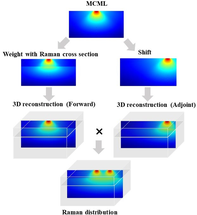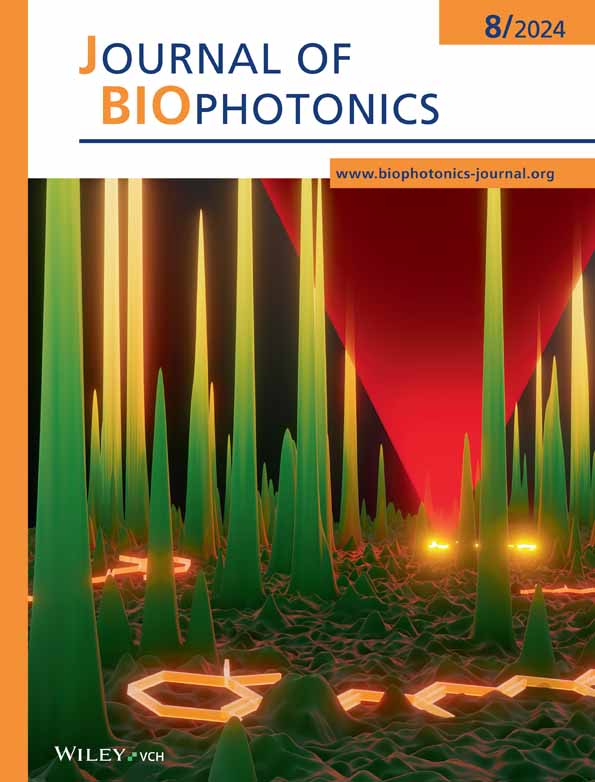Determining ideal offsets of spatially offset Raman spectroscopy for transcutaneous measurements—A Monte Carlo study
Corresponding Author
Keren Chen
College of Medicine and Biological Information Engineering, Northeastern University, Shenyang, China
Foshan Graduate School of Innovation, Northeastern University, Foshan, China
Correspondence
Keren Chen and Shuo Chen, College of Medicine and Biological Information Engineering, Northeastern University, Shenyang, 110169, China.
Email: [email protected] and [email protected]
Search for more papers by this authorMengya sun
College of Medicine and Biological Information Engineering, Northeastern University, Shenyang, China
Foshan Graduate School of Innovation, Northeastern University, Foshan, China
Search for more papers by this authorCorresponding Author
Shuo Chen
College of Medicine and Biological Information Engineering, Northeastern University, Shenyang, China
Key Laboratory of Intelligent Computing in Medical Image, Ministry of Education, Northeastern University, Shenyang, China
Correspondence
Keren Chen and Shuo Chen, College of Medicine and Biological Information Engineering, Northeastern University, Shenyang, 110169, China.
Email: [email protected] and [email protected]
Search for more papers by this authorCorresponding Author
Keren Chen
College of Medicine and Biological Information Engineering, Northeastern University, Shenyang, China
Foshan Graduate School of Innovation, Northeastern University, Foshan, China
Correspondence
Keren Chen and Shuo Chen, College of Medicine and Biological Information Engineering, Northeastern University, Shenyang, 110169, China.
Email: [email protected] and [email protected]
Search for more papers by this authorMengya sun
College of Medicine and Biological Information Engineering, Northeastern University, Shenyang, China
Foshan Graduate School of Innovation, Northeastern University, Foshan, China
Search for more papers by this authorCorresponding Author
Shuo Chen
College of Medicine and Biological Information Engineering, Northeastern University, Shenyang, China
Key Laboratory of Intelligent Computing in Medical Image, Ministry of Education, Northeastern University, Shenyang, China
Correspondence
Keren Chen and Shuo Chen, College of Medicine and Biological Information Engineering, Northeastern University, Shenyang, 110169, China.
Email: [email protected] and [email protected]
Search for more papers by this authorKeren Chen and Mengya sun are joint co-first authors.
Abstract
Spatially offset Raman spectroscopy (SORS) is valuable for noninvasive bone assessment but requires a clearer understanding of how offset distances influence detection depth. To address this, our study devised a forward-adjoint Monte Carlo multi-layer (MCML) model to simulate photon paths in SORS, aiming to determine optimal offsets for various tissue types. We examined photon migration at offsets between 0 and 15 mm against layered phantoms of differing thicknesses and compositions to optimize the signal-to-noise ratio for bone layers. The findings highlight that optimal offsets are contingent on tissue characteristics: a metacarpal beneath 2.5 mm of tissue had an ideal offset of 6.7 mm, while a tibia with 5 mm of soft tissue required 10–11 mm. This precise calibration of SORS via MCML modeling promises substantial improvements in bone health diagnostics and potential for expansive medical applications.
CONFLICT OF INTEREST STATEMENT
The authors declare that there are no conflicts of interest related to this publication.
Open Research
DATA AVAILABILITY STATEMENT
The data that support the findings of this study are available from the corresponding author upon reasonable request.
REFERENCES
- 1P. Matousek, N. Stone, Chem. Soc. Rev. 2016, 45, 1794.
- 2C. Eliasson, N. Macleod, P. Matousek, Anal. Chem. 2007, 79, 8185.
- 3K. Buckley, C. G. Atkins, D. Chen, H. G. Schulze, D. V. Devine, M. W. Blades, R. F. B. Turner, Analyst 2016, 141, 1678.
- 4P. Matousek, E. R. C. Draper, A. E. Goodship, I. P. Clark, K. L. Ronayne, A. W. Parker, Appl. Spectrosc. 2006, 60, 758.
- 5K. Chen, C. Massie, H. A. Awad, A. J. Berger, Biomed. Opt. Express 2021, 12, 7517.
- 6C. Shu, K. Chen, M. Lynch, J. R. Maher, H. A. Awad, A. J. Berger, Biomed. Opt. Express 2018, 9, 4781.
- 7M. V. Schulmerich, K. A. Dooley, T. M. Vanasse, S. A. Goldstein, M. D. Morris, Appl. Spectrosc. 2007, 61, 671.
- 8M. V. Schulmerich, K. A. Dooley, M. D. Morris, T. M. Vanasse, S. A. Goldstein, J. Biomed. Opt. 2006, 11, 060502.
- 9K. Sowoidnich, J. H. Churchwell, K. Buckley, A. E. Goodship, A. W. Parker, P. Matousek, J. Raman Spectrosc. 2016, 47, 240.
- 10C. Massie, E. Knapp, K. Chen, A. J. Berger, H. A. Awad, J. Biomech. 2021, 116, 110243.
- 11K. A. Esmonde-White, F. W. L. Esmonde-White, M. D. Morris, B. J. Roessler, Analyst 2011, 136, 1675.
- 12F. W. Esmonde-White, K. A. Esmonde-White, M. D. Morris, Photonic Therapeutics and Diagnostics VI, SPIE, Bellingham, Washington 2010, p. 652.
- 13J.-L. H. Demers, S. C. Davis, B. W. Pogue, M. D. Morris, Biomed. Opt. Express 2012, 3, 2299.
- 14I. E. I. Petterson, F. W. L. Esmonde-White, W. de Wilde, M. D. Morris, F. Ariese, Analyst 2015, 140, 2504.
- 15P. I. Okagbare, F. W. L. Esmonde-White, S. A. Goldstein, M. D. Morris, Analyst 2010, 135, 3142.
- 16P. I. Okagbare, D. Begun, M. Tecklenburg, A. Awonusi, S. A. Goldstein, M. D. Morris, J. Biomed. Opt. 2012, 17, 090502.
- 17F. W. Esmonde-White, K. A. Esmonde-White, M. R. Kole, S. A. Goldstein, B. J. Roessler, M. D. Morrisa, Analyst 2011, 136, 4437.
- 18J. L. Demers, F. W. L. Esmonde-White, K. A. Esmonde-White, M. D. Morris, B. W. Pogue, Biomed. Opt. Express 2015, 6, 793.
- 19M. V. Schulmerich, Subsurface and transcutaneous Raman spectroscopy, imaging, and tomography, University of Michigan, Ann Arbor, Michigan 2008.
- 20S. Wang, J. Chen, F. Zhang, M. Zhao, X. Cui, S. Chen, Med. Phys. 2022, 49, 1209.
- 21M. Keijzer, S. L. Jacques, S. A. Prahl, A. J. Welch, Lasers Surg. Med. 1989, 9, 148.
- 22G. Yoon, S. A. Prahl, A. J. Welch, Appl. Opt. 1989, 28, 2250.
- 23K. Furutsu, J. Math. Phys. 1980, 21, 765.
- 24S. Arridge, M. Schweiger, M. Hiraoka, D. T. Delpy, Med. Phys. 1993, 20, 299.
- 25M. Schweiger, S. R. Arridge, M. Hiraoka, D. T. Delpy, Med. Phys. 1995, 22, 1779.
- 26L. Wang, S. L. Jacques, J. Opt. Soc. Am. A Opt. Image Sci. Vis. 1993, 10, 1746.
- 27L. Wang, S. L. Jacques, L. Zheng, Comput. Methods and Programs in Biomed. 1995, 47, 131.
- 28L. Wang, S. L. Jacques, Med. Phys. 1994, 21, 1081.
- 29M. D. Keller, R. H. Wilson, M. A. Mycek, A. Mahadevan-Jansen, Appl. Spectrosc. 2010, 64, 607.
- 30P. Matousek, C. Conti, C. Colombo, M. Realini, Appl. Spectrosc. 2015, 69, 1091.
- 31R. Zhang, X. Zhang, C. Hu, C. Chen, AIP Adv. 2023, 13, 105130.
- 32R. H. Wilson, K. A. Dooley, M. D. Morris, M.-A. Mycek, Optics in Bone Biology and Diagnostics, SPIE, Bellingham, Washington 2009, p. 24.
- 33R. J. Crilly, W. F. Cheong, B. Wilson, J. R. Spears, Appl. Opt. 1997, 36, 6513.
- 34S. R. Arridge, J. C. Hebden, Phys. Med. Biol. 1997, 42, 841.
- 35J. Swartling, A. Pifferi, A. M. K. Enejder, S. Andersson-Engels, J. Opt. Soc. Am. A Opt. Image Sci. Vis. 2003, 20, 714.
- 36G. W. Auner, M. A. Brusatori, Cancer Metastasis Rev. 2020, 39, 1019.
- 37A. Mahadevan-Jansen, C. A. Patil, I. J. Pence, Biomedical photonics handbook, CRC Press, Boca Raton, Florida 2014, p. 782.
- 38W.-C. Shih, K. L. Bechtel, M. S. Feld, Opt. Express 2008, 16, 12726.
- 39P. Matousek, M. D. Morris, N. Everall, I. P. Clark, M. Towrie, E. Draper, A. Goodship, A. W. Parker, Appl. Spectrosc. 2005, 59, 1485.
- 40A. N. Bashkatov, E. A. Genina, V. I. Kochubey, V. V. Tuchin, J. Phys. D: Appl. Phys. 2005, 38, 2543.
- 41S. L. Jacques, Phys. Med. Biol. 2013, 58, R37.
- 42R. H. Wilson, “ Mathematical Models of Light Transport in Biological Tissues for Quantitative Clinical Diagnostic Applications,” University of Michigan, Ann Arbor, Michigan 2012.
- 43M. D. Keller, S. K. Majumder, A. Mahadevan-Jansen, Opt. Lett. 2009, 34, 926.
- 44K. Buckley, J. G. Kerns, A. W. Parker, A. E. Goodship, P. Matousek, J. Raman Spectrosc. 2014, 45, 188.
- 45J. R. Maher, A. J. Berger, Appl. Spectrosc. 2010, 64, 61.
- 46A. Pejović-Milić, J. A. Brito, J. Gyorffy, D. R. Chettle, Med. Phys. 2002, 29, 2687.
- 47K. Buckley, J. G. Kerns, J. Vinton, P. D. Gikas, C. Smith, A. W. Parker, P. Matousek, A. E. Goodship, J. Raman Spectrosc. 2015, 46, 610.
- 48J. Kiefer, Anal. Chem. 2019, 91, 1764.
- 49Y. Qi, R. Zhang, P. Rajarahm, S. Zhang, A. B. Ebrahim Attia, R. Bi, M. Olivo, Anal. Chem. 2023, 95, 5240.




